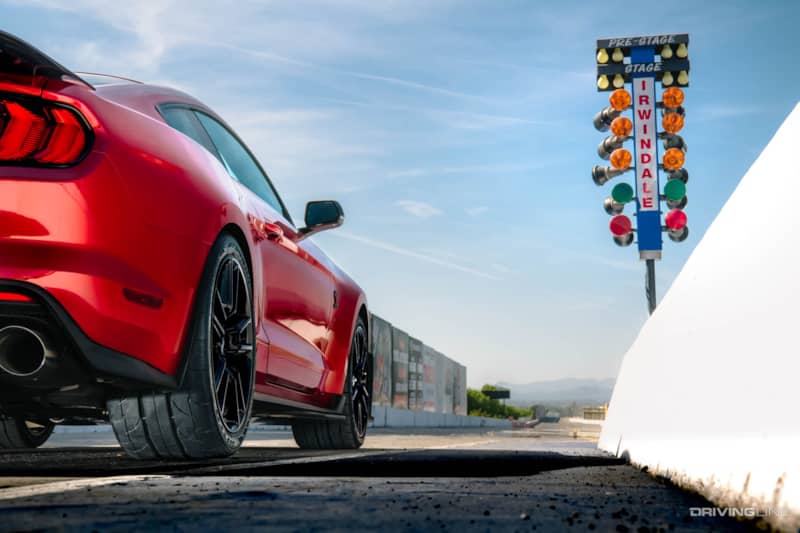The 2021 BMW M5 Competition Is A Twin-Turbo V8 Sedan That Takes On America's Best Muscle Cars
Few performance sedans are as gnarly as the 2021 BMW M5 Competition. Boasting 617hp (a 17 pony boost over the 'standard' M5), a twin-turbo V8, and handling that can match many sports cars when unleashed on a road course, the M5 Competition is aimed at buyers who need a comfortable daily driver that can also take home the pole position on the weekends.

While the BMW's overwhelming engine output is impressive no matter how you slice it, the horsepower wars that have been waged over the past decade have seen all manner of automobiles catch up to what was once exclusively supercar territory. In particular, a pair of Detroit denizens have crept past the M5 Competition on the dyno, providing intriguing alternatives to the six-figure German track star.

Which of America's mightiest muscle machines offer a potential match for the M5 with the hammer down? Let's take a look at one sedan, and one coupe, that are willing and able to go toe-to-toe with the best M has to offer.
Dodge Charger Hellcat Redeye
The Hellcat hits just keep coming with the Redeye version of Dodge's widebody Charger. The most powerful family sedan ever built relies on a 6.2L supercharged V8 that churns out 797 horses and 707 lb-ft of torque, matched with an eight-speed automatic transmission that sends that towering wave of twist to the rear wheels.

In a straight line, the BMW M5 Competition vs Charger Hellcat Redeye are surprisingly close. Despite offering nearly 200 less horsepower than the Redeye, the M5 Competition manages to spring to 60-mph in a startling 3.2 seconds, aided and abetted by a 300 lb weight advantage and a launch control system that makes use of the vehicle's standard all-wheel drive. In the real world, some tests have sliced that time down to 2.9 seconds, and there's even drive mode that lets you disconnect the front axles so you can do as many smoky burnouts as you want.

The Charger Hellcat Redeye is advertised at 3.5 seconds, which is just a smidge faster than the 'regular' Hellcat, a solid indication of how hard that extra 80 horsepower is to handle. In terms of top speed, however, the Dodge has the BMW beat, topping out at an aero-limited 203 miles per hour, while the BMW is restricted to 189 miles per hour.

While quickness is comparable, there are two areas where the Charger Hellcat Redeye and the M5 Competition starkly diverge. The first is handling: while the Dodge is perfectly competent on a race track, its bulk and aging platform have a hard time keeping up with the much more modern BMW, especially now that the latter's all-wheel drive system has attenuated some of the more lively aspects of its 4.4L twin-turbo V8.

More telling is refinement. The Dodge Charger isn't nearly as sumptuous inside as the BMW M5, which feels like an obvious statement considering the enormous price gap between the two models ($111,100 for the BMW versus $72,095 for the Dodge). It extends to the quality of the materials inside, the fit and finish with which they are installed, and the technologies available (safety, driver assistance, and infotainment).
Ford Shelby GT500
Does it seem strange to be comparing a Ford Mustang to a high-buck import like the BMW M5 Competition? Not when it's the Shelby GT500, whose price tag starts at $72,000, but jumps to $92,595 with the Carbon Fiber Track Package in the mix (carbon fiber wheels, aero, sticky track tires, rear seat delete), and can even push past $95k depending on options.

If the idea of a nearly-$100,000 window sticker on a Mustang doesn't blow your mind, then maybe the Shelby GT500's performance stats will. The most powerful pony to date features a 5.2L V8 that's been supercharged to deliver 760hp and 625 lb-ft of torque. A seven-speed dual clutch automated manual is the only transmission available, and the vehicle's rear wheels are responsible for transmission all of that grunt to the ground.

That they do fairly well, with a 0-60 time in the same range as the Hellcat but again a bit behind the M5 in the real world due to the latter's all-wheel drive advantage. If you can find a long enough stretch of road, you'll come up just short of running down the BMW at the top end, too, as the Mustang's terminal velocity is limited to 180 mph (9 mph short of the M5 Competition).

With its horsepower advantage somewhat negated in a drag race by a lack of traction, the Ford Shelby GT500 more than makes up for it when challenging the M5 to a time attack. The baddest of Mustangs has a history of spanking even exotics on the right road course, posting lap times that best mid-engine models from McLaren and Lamborghini, thanks to its sharp focus on track performance. Sure, the M5 will keep you better coddled on your way to and from your next high performance driving event, but the GT500 will snag you FTOD.
More From Driving Line
- What's it like to daily drive a 797 horsepower Hellcat Redeye? We put the Challenger to the week-long test.







